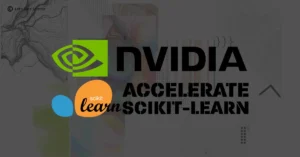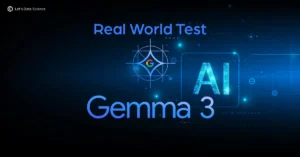Summarized Audio Version:
The Gemma 3 AI Model from Google marks a major leap forward in accessible AI modeling. Launched on March 12, 2025, it builds on the success of the Gemma 2 line, which celebrated over 100 million downloads in its first year. Now, Gemma 3 arrives with improved multimodality, an expanded context window, and extensive multilingual capabilities. Above all, it is designed to run on a single GPU or TPU without sacrificing performance.
This article walks you through what makes Gemma 3 stand out for data scientists, developers, and anyone eager to leverage cutting-edge AI in their workflows.
Quick Overview of Gemma 3
Highlights:
| Feature | Gemma 3 |
|---|---|
| Model Sizes | 1B, 4B, 12B, 27B |
| Context Window (Tokens) | 32K (1B model), 128K (4B, 12B, 27B) |
| Multimodal (Vision + Text) | Supported in 4B, 12B, 27B versions |
| Multilingual Coverage | 140+ languages |
| Efficiency | Single-GPU or TPU capable |
| Quantized Versions | Official releases for smaller footprint |
| Example Use Cases | Text analysis, code, large docs, images |
Gemma 3 inherits its core research and technology from Google’s flagship Gemini 2.0 models. Because of this advanced foundation, it delivers robust math, reasoning, coding, and chat capabilities. It also addresses a global audience by covering more than 140 languages out of the box.
Why Gemma 3 Matters
1. Expanded Context Window
A standout feature of Gemma 3 is its large context window. Larger variants (4B, 12B, 27B) support up to 128,000 tokens, whereas the 1B model offers a 32,000-token window. This leap in capacity:
- Enables Lengthy Document Analysis
Researchers and data scientists can feed extensive text or codebases to the model, making it easier to summarize, question, or analyze large documents in a single pass. - Promotes Complex Reasoning
By handling more information at once, Gemma 3 has a better chance of maintaining context over lengthy prompts. Therefore, it can generate more coherent responses to multi-step queries. - Supports Creative Workflows
Writers and content creators can work with in-depth text prompts or stories without having to split them into smaller chunks.
However, practical usage suggests that near-perfect performance typically stays closer to a 32K token range. Even so, having 128K as an upper limit offers considerable flexibility.
2. Multimodal Capabilities
Previously, Gemma models were text-focused. Now, Gemma 3’s 4B, 12B, and 27B variants include image-understanding abilities. This multimodality:
- Enhances Visual QA
Users can ask text-based questions about an uploaded image. For instance, “How many cars are in this photo?” or “What does the label say?” - Supports Image Analysis & Captioning
Gemma 3 can identify objects, describe scenes, and even process text within images (though OCR accuracy can vary). - Simplifies Workflows
Instead of juggling separate vision models and text models, you can adopt a single approach for integrated tasks.
Under the hood, Gemma 3 uses a frozen SigLIP encoder to process images. It then passes the resulting “image tokens” into the language model layers for a unified output.
3. Broad Multilingual Support
Gemma 3 stands out for its multilingual reach:
- Over 140 Languages
This includes widespread coverage of Asian, European, and Middle Eastern languages, among others. - Tokenizer Upgrades
The new SentencePiece tokenizer, borrowed from Gemini 2.0, has 262,000 entries. It especially improves the handling of languages like Chinese, Japanese, and Korean. - Real-World Global Use Cases
Many community projects—such as SEA-LION (focusing on Southeast Asian languages) and BgGPT (focusing on Bulgarian)—are already building on Gemma 3 to localize AI further.
4. Efficiency and Accessibility
Another reason Gemma 3 resonates with developers is its efficiency:
- Single-GPU or TPU Deployment
The 27B model can run on a single NVIDIA H100, whereas some competing models require larger GPU clusters. Smaller variants (1B and 4B) can fit on a consumer-grade gaming GPU. - Quantized Releases
Official quantized weights reduce model size and memory usage. This leads to faster inference speeds, lower hardware demands, and cheaper deployment. - Integration with Popular Tools
Gemma 3 works seamlessly with Hugging Face Transformers, JAX, PyTorch, Google AI Studio, Vertex AI, and more. Because of this, you can experiment easily on your platform of choice.
Performance and Comparisons
Gemma 3’s 27B variant has reported an Elo score of about 1338 on the Chatbot Arena, placing it among the top open models. It often competes with larger models, such as Llama 3-405B and DeepSeek-V3, in user preference tests. Here is a simplified comparison of high-level features:
| Attribute | Gemma 3 27B | Llama 3 70B | DeepSeek-V3 (approx.) |
|---|---|---|---|
| Parameter Count | ~27B | ~70B | ~60B+ |
| Context Window | 128K tokens | 128K tokens | 8K – 64K tokens |
| Multimodality | Yes | No (by default) | No (text only) |
| Hardware Requirements | 1 GPU (H100) | Multiple GPUs | Often 16+ GPUs |
| Reported Elo Score | ~1338 | Higher (varies) | ~1300+ |
| Multilingual Coverage | 140+ languages | 30+ languages | 50+ languages |
Key Takeaways:
- Gemma 3 offers a strong balance of capabilities, context window size, and hardware efficiency.
- Llama 3’s higher-parameter versions might surpass Gemma 3 in certain tasks, yet they generally demand more computing resources.
- DeepSeek-V3 can excel in specialized tasks, but its significant GPU demands make it less accessible to smaller teams.
Real-World Use Cases
1. Text and Document Analysis
- Large Document Summaries: Extract key insights from extensive research papers, technical guides, or books.
- Detailed QA: Ask multi-turn questions about a lengthy text passage.
2. Multimodal Applications
- Visual Question Answering (VQA): Answer queries about images or diagrams.
- Image Captioning: Automatically generate textual descriptions for pictures, beneficial for product catalogs or accessibility solutions.
3. Coding and Debugging
- Extended Code Context: Input entire code files or multiple modules for commentary, refactoring advice, or debugging.
- Function Calling: Automate tasks by asking Gemma 3 to generate structured outputs or call external functions for data processing.
4. Multilingual Chatbots
- Language-Agnostic Support: Build a single model-based customer service chatbot that handles inquiries in dozens of languages.
- Cultural Nuances: Offer localized greetings or product recommendations across global user bases.
5. Research and Development
- Academic Papers: Summarize cross-lingual research or complex publications.
- Domain-Specific Tuning: Fine-tune Gemma 3 for specialized fields like healthcare, finance, or law.
Getting Started with Gemma 3
Access & Integration
- Hugging Face: Download the weights (pre-trained or instruct-tuned) and integrate via
transformers. - Google AI Studio: Experiment in your browser using an API key and the Google GenAI SDK.
- Local Inference: Deploy smaller variants on a single GPU or CPU with quantized versions, such as Gemma.cpp.
- Cloud Platforms: Run at scale on Vertex AI, Cloud Run, or the Google GenAI API.
Fine-Tuning and Customization
- Data Preparation: Collect or label a dataset with domain-specific examples.
- Efficient Training Recipes: Use low-rank adaptation (LoRA) or parameter-efficient finetuning to minimize compute overhead.
- Verify Results: Evaluate your new model on both domain-specific tasks and general benchmarks.
Community & “Gemmaverse”
- 60,000+ Model Variants: Discover specialized versions from a thriving community on Hugging Face or Kaggle.
- ShieldGemma 2: Incorporate this 4B image safety checker if you need to moderate or filter images.
- Academic Program: Apply for Google Cloud credits, especially if you’re in academia and want to explore large-scale experiments with Gemma 3.
Challenges and Considerations
- Hallucinations
Gemma 3 can still generate inaccurate or nonsensical answers. Therefore, validating outputs is crucial for high-stakes tasks. - Bias and Fairness
Any open model trained on vast data may reflect social or cultural biases. Be sure to monitor and correct these issues, particularly in user-facing applications. - Complex Tasks (Coding & Math)
Early adopters note that Gemma 3 may falter in advanced programming tasks or intricate math problems. Always test for reliability when automating these workflows. - Performance Over Large Contexts
While 128K tokens is a headline feature, real-world performance can degrade near those limits. Planning for a more modest 32K usage might be practical. - Constant Updates
AI knowledge evolves fast. If you require the latest facts, retrieval-based augmentation or frequent fine-tuning is recommended.
Conclusion
Gemma 3 launches a new era of accessible AI by offering a large context window, multimodal input processing, and broad language coverage—all while being highly efficient on single GPUs or TPUs. Its seamless integration with popular tools makes it a compelling choice for data scientists and developers who need powerful, adaptable models without managing massive compute clusters.
Furthermore, the Gemmaverse continues to expand, showcasing fine-tuned variants and community innovations. If you’re seeking a versatile, open AI model that excels in text analysis, coding assistance, image understanding, and multilingual interactions, Gemma 3 is a strong candidate.
Next Steps
- Try Gemma 3 directly on Google AI Studio for a quick demo.
- Download the weights from Hugging Face or Kaggle to begin experimenting.
- Fine-tune it for your specialized domain or language.
- Join the Gemmaverse community and share your own custom model variants.
With Gemma 3, Google underscores its commitment to fostering an inclusive AI ecosystem. By balancing performance, safety, and accessibility, this new model stands ready to transform how we engage with large-scale text and images—one device, language, or project at a time.




